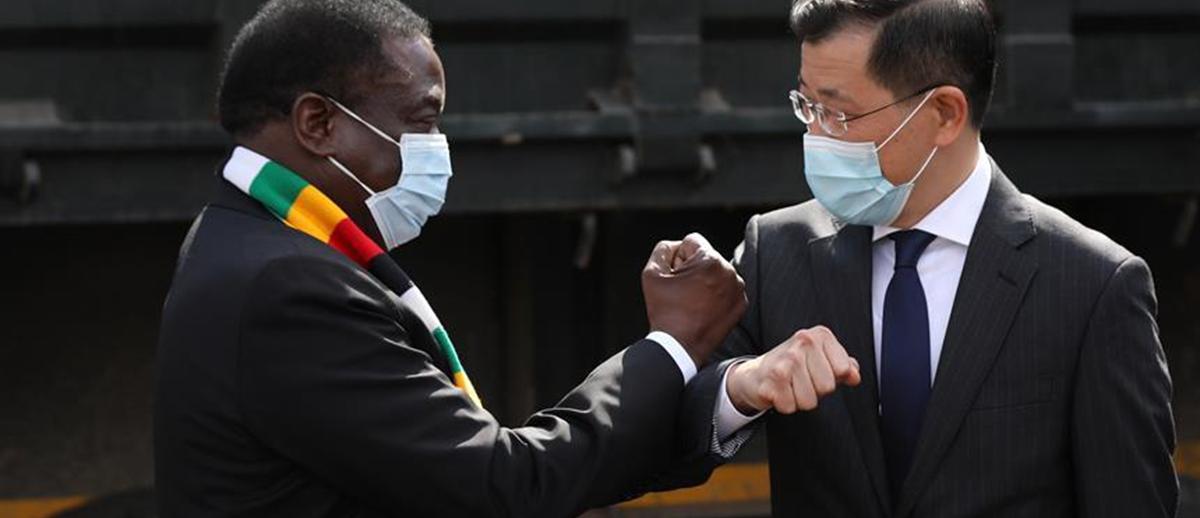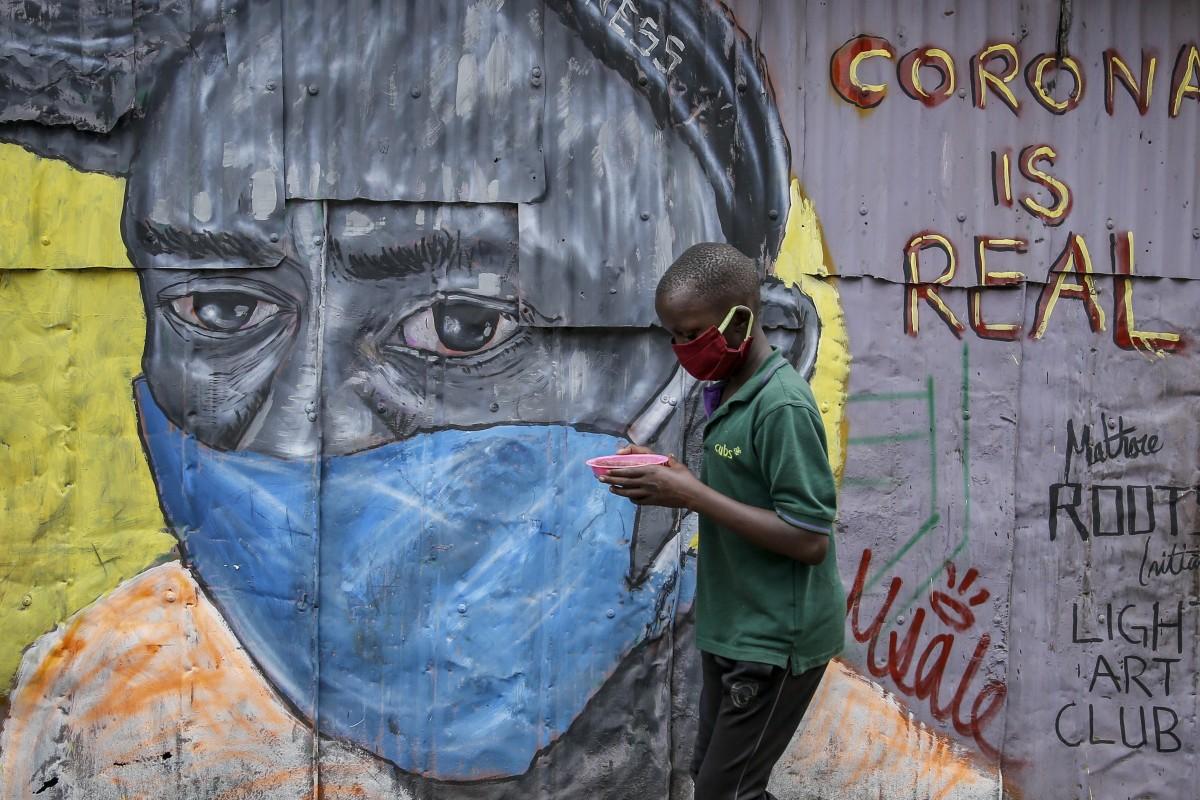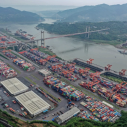COVID-19 and ‘Made in China’: All for Itself?
archive


Zimbabwean President Emmerson Mnangagwa (L) and Chinese ambassador to Zimbabwe Guo Shaochun greet each other at a handover ceremony of anti-COVID-19 medical supplies in Harare, Zimbabwe, on June 11 2020.
COVID-19 and ‘Made in China’: All for Itself?
During a time of dire global need for assistance and cooperation in mitigating the shortage of medical supplies and personal protective equipment (PPE) in the fight against COVID-19, attention has been drawn to China’s global outreach to other countries. How different countries tackle the pandemic leads to often acrimonious regional and global comparisons and competition, which has generated conflict in light of the varying political, economic, and diplomatic gains, damage, strategies, and objectives of states.
We have seen the United States ‘hijack’ masks ordered by France and Canada from China, causing these countries to publicly call out U.S. officials’ misbehavior. But like the U.S., France has done the same with Sweden—only returning the masks later after the Swedes threatened economic countermeasures. There has been a ‘mask war’ between countries that have ordered masks from China. Some have paid higher prices to quickly get ahold of PPE in order to protect their citizens from the spread of the disease. Such a ‘race’ or ‘war’ for ‘made-in-China’ masks shows the limitations of many countries, including industrialized countries, as well as their lack of anticipation to manufacture and sustain stocks of the kinds of equipment and supplies needed to battle the pandemic.
Chinese Capacity
China has managed to provide PPE nationwide as well as globally, assisting many countries in their fight against COVID-19. Some observers argue that because COVID-19 spread from there, China has had the advantage to prepare itself ahead of other countries caught ‘by surprise’, which created the subsequent chaos and panic to secure PPE for their frontline workers, patients, and other high-risk populations. Others point to China’s reach across the globe during the pandemic—referred to as ‘mask diplomacy’—as an expansion and strengthening of its global soft power.
However, we should refer back to policies enacted under the ‘Made in China 2025’ strategic plan,1 which directed China to produce everything it needs by and for itself. After acquiring strategic know-how at the very early stage of its opening up in the late 1980s, China has managed to establish its own manufacturing base across a wide range of economic sectors. The delocalization of foreign companies to China (seeking new markets and lower production and labor costs) has contributed to the development of robust Chinese manufacturing. Not only has China successfully established these industries, but the government has accompanied this industrial development with policies and five-year plans in order to assess as well as monitor progress in different sectors, especially in key sectors where the country has comparative and competitive advantages.
A few years ago, China’s government fostered an import-driven over an export-driven plan in order to balance and restructure the country’s economy. However, with the pandemic we are seeing a resurgence of China’s exports as manufacturing in many countries has slackened if not stopped. In these countries economic recovery will take time, due to (in some cases) limited government support and the health risks that many workers may face upon returning to work, driving many governments to be cautious in order to avoid further spread. With the apparent limitations in the ability of industrialized countries to provide PPE to their health workers and populations, interest has risen to support domestic manufacturing in a number of key areas in order to break dependence on China in future crises. On May 18, 2020, Germany’s chancellor and France’s president met to discuss harmonizing EU member states’ debts. During the meeting both leaders advocated that a centralized EU health system must be the EU’s top priority, stating that efforts to work towards a centralized health system should lead to the manufacture and provision of PPE for EU member states during health crises.
[I]nterest has risen to support domestic manufacturing in a number of key areas in order to break dependence on China in future crises.
China has production surplus to cater to the needs—and not just the medical needs—of its populations as well as to export to global markets (the country is the world’s largest supplier of medical equipment). At the same time, China’s global and transnational brands like Alibaba, Huawei, WeChat, and Baidu are also reaching out to Chinese diasporas and generating interest among a huge number of non-Chinese abroad.2 This expansion of Chinese tech at a time when the rest of the world is reeling from the coronavirus pandemic is raising concern and even concerted pushback by some countries, but at the very least it is testament to the vigor of Chinese economic activity during the COVID-19 crisis.
Meanwhile, in Africa
The current world situation sees newly surging cases in many areas—particularly in Europe, which is among the hardest hit continents in terms of cases and deaths. But in some parts of Africa the pandemic has grown even faster. African countries began to discover their first COVID-19 cases in early March, and while still relatively low compared to the rest of the world, the growing number of cases between June and August has raised concerns about a surge of COVID-19 in many African countries that prematurely lifted lockdown measures and curfews. The lack of adequately equipped hospitals and health facilities makes it difficult to stop the progress of the pandemic among populations in Africa. Despite the fact that the continent has many renowned infectious disease specialists, the lack of coherent public health policy and infrastructure has revealed challenges that are enormous for African states’ health systems and prevention campaigns, compounded by the urgent need to acquire and distribute masks, PPE, gloves, and hand sanitizer among health workers in particular, and national populations in general.

An informational mural in the Mathare slum of Nairobi, Kenya, April 2020. (Photo credit: AP)
Thus, COVID-19 has revealed the need for African countries to reconsider their health policies, reform their health systems, and to industrialize in the health sector by setting up manufacturing companies in various areas. With the world caught off guard by the surge of the pandemic, economic and political nationalism and reliance on “one’s own” means have proven disastrous globally. Many countries have learned their lessons. But African countries, which have limited capability to acquire and manufacture enough equipment and protective gear, only started to make orders for PPE after the pandemic was already within their borders. In some countries, tailors have been mobilized to make artisanal masks, but their production capacity is drastically limited compared to the potential of manufacturing companies to produce surpluses over time. Here again, China has donated large quantities of PPE and sent medical teams to many African states over the past several months. Such assistance contributes to China’s soft power and is another example of its ‘mask diplomacy’.
Conclusion
Even though COVID-19 is a global pandemic that has led to worldwide health and socio-economic crisis, it also helps to direct attention to important political-economic challenges at the national level that involve developing key capacity in the health sector of countries everywhere. In the future, such capacity building could help to mitigate risks and counter political and diplomatic tensions at the local, national, regional, and global levels. While COVID-19 has revealed the limitations of scientists, governments, health systems, and economies, an honest assessment of the example of China could be a starting point for learning and improving so as to face future global health crises with more robust capacity.
1. As part of China’s 13th five-year plan, ‘Made in China 2025’ aims at developing the manufacturing sector in China and moving from the production of low-end products to high added value products and services across various key industries.
2. For example, there are 100 million WeChat users outside of China. Overseas Chinese rely on Chinese social media platforms like WeChat for many reasons (economic, business, social, communication and so on). But even though WeChat enables many Chinese to communicate and do business, for some it also involves the inconveniences of censorship, lack of freedom of speech, authoritarian control, and propaganda.



